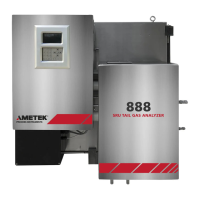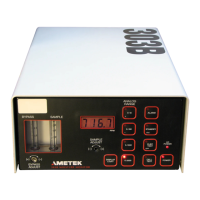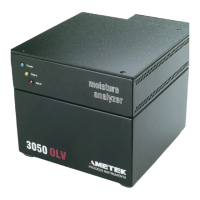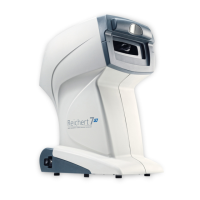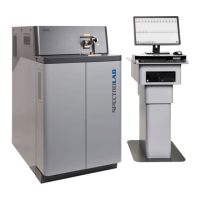Maintenance and Troubleshooting | 6-19
“P/N” refers to Part Number.
To clean and replace parts in the Column Block (see Figure 6-4):
Hazardous Locations
Before proceeding, test the area around the analyzer for explosive
gases and proceed only when the area is found to be safe.
Do not remove the cover of the Explosion-Proof Digital Communica-
tions Port on the front of the Lower Enclosure, do not connect a serial
cable to the Communications Port, do not open the Upper/Lower En-
closures, and do not power up/down the analyzer or computer if there
is an explosive gas atmosphere present.
1. Connect a serial cable between the computer and the analyzer’s Com-
munications Port. Using the Configurator Software, change the Flow
Control setting to ‘3’ (zero). Click OK then Apply. Do not save the
changes to EEPROM.
2. If the analyzer uses Measured Pressure Compensation (optional),
change it to Fixed mode so that a “f: Sample gas pressure too low”
alarm does not occur. To do this, view the Cell/Misc Parameters dialog
box and enter a value in the Default Cell Pres (pressure compensa-
tion) field that is the same as, or approximately, the Measuring Cell
pressure. Refer to “Cell/Miscellaneous (Compensation) Parameters” in
Chapter 4.
Close the sample inlet valve. Backpurge the analyzer sample system
with Zero gas for 2–3 minutes.
3. Change the Flow Control to ‘4’ (shut-in/shut-off). Click Apply (next to
Flow Control) and then click OK.
Bleed down the sample system to atmospheric pressure (check gauge).
Close the valve on the Vent Line (or cap the Vent outlet).
To avoid tearing the Membrane Filters in the Filterblock, always bleed
down the sample system pressure on the downstream (outlet) side of
the Filterblock. Pressure differentials of more than 210 KPA (30 PSI)
from the inlet side to the outlet side can tear the Filters and they will
have to be replaced.
NOTE
!
CAUTION
!
WARNING
Setup (tab)
Gas Calibration<<Flow
Control>>
Setup (tab)Cell/Misc

